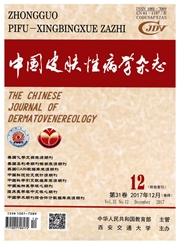

 中文摘要:
中文摘要:
目的分析抗核小体抗体(AnuA)与系统性红斑狼疮(SLE)患者临床特征及其活动性的相关性。方法采用回顾性研究并用调查表的形式收集694例AnuA阳性患者临床资料,并与733例An—uA阴性病人进行比较分析。结果AnuA与蝶形红斑、光敏感、关节炎、心包炎及狼疮性肾炎的发生相关(P〈0.05);AnuA阳性可伴有其他自身抗体及免疫学指标异常出现;AnuA阳性与肾脏损害指标血尿、蛋白尿、管型尿及尿素氮的发生率明显相关(P〈0.05);AnuA阳性与系统性红斑狼疮疾病活动性指数(SLEDAI)相关(P〈0.05)。结论AnuA可能是SLE的又一标志性抗体,其检测可用于疾病的早期诊断,有助于SLE疾病活动度、严重程度及狼疮肾炎(lupus nephritis,LN)的判断。
 英文摘要:
英文摘要:
Objective To study the relation of Anti-nucleosome antibodies (AnuA) with both clinical features and disease activity of patients with systemic lupus erythematosus(SLE) in Chinese Han. Methods We have retrospectively reviewed the clinical data of 694 SLE patients with positive AnuA by questionnaire, and compared them with 733 SLE with negative AnnA. Results AnuA were significantly correlated with the prevalence of malarrash, photosensitivity, arthritis, pericarditis and LN in SLE patients ( P 〈 0.05 ). They were more likely coexisted with other serological abnormalities including antinuclear antibodies. AnuA were significantly associated with the index of kidney damage such as hematuria, proteinuria, urinary casts and BUN(P 〈 0.05 ). The SLE Disease Activity Index (SLEDAI) score was signifificant difference between the two groups ( P 〈 0.05). Conclusion AnuA may be a well marked antibody for SLE. Detection of AnuA may be a useful tool for diagnosis of SLE in early stages and contribute to judging diseases activity and Iupus nephritis.
 同期刊论文项目
同期刊论文项目
 同项目期刊论文
同项目期刊论文
 A single-nucleotide polymorphism rs4639966 in 11q23.3 is associated with clinical features of system
A single-nucleotide polymorphism rs4639966 in 11q23.3 is associated with clinical features of system Down-regulated expression of IKZF1 mRNA in peripheral blood mononuclear cells from patients with sys
Down-regulated expression of IKZF1 mRNA in peripheral blood mononuclear cells from patients with sys A single nucleotide polymorphism rs9468925 of MHC region is associated with clinical features of gen
A single nucleotide polymorphism rs9468925 of MHC region is associated with clinical features of gen A single nucleotide polymorphisms rs4639966 in 11q23.3 is associated with clinical features of syste
A single nucleotide polymorphisms rs4639966 in 11q23.3 is associated with clinical features of syste Variants in TNFSF4, TNFAIP3, TNIP1, BLK, SLC15A4 and UBE2L3 interact to confer risk of systemic lupu
Variants in TNFSF4, TNFAIP3, TNIP1, BLK, SLC15A4 and UBE2L3 interact to confer risk of systemic lupu Meta-analysis Followed by Replication Identifies Loci in or near CDKN1B, TET3, CD80, DRAM1, and ARID
Meta-analysis Followed by Replication Identifies Loci in or near CDKN1B, TET3, CD80, DRAM1, and ARID The association between a single nucleotide polymorphism rs11966200 in MHC region and clinical featu
The association between a single nucleotide polymorphism rs11966200 in MHC region and clinical featu TNIP1, SLC15A4, ETS1, RasGRP3 and IKZF1 are associated with clinical features of systemic lupus eryt
TNIP1, SLC15A4, ETS1, RasGRP3 and IKZF1 are associated with clinical features of systemic lupus eryt 期刊信息
期刊信息
